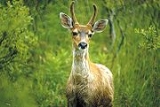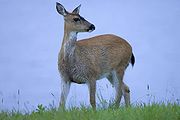
Sitka Deer
Encyclopedia
The Sitka deer or Sitka black-tailed deer (Odocoileus hemionus sitkensis), is a subspecies of mule deer
(Odocoileus hemionus), and similar to another subspecies the black-tailed deer
(O. h. colombianus). Their name originates from Sitka, Alaska. Weighing in on average between 80 lbs , Sitka deer are characteristically smaller than other types of black-tailed deer. Reddish-brown in the summer, their coats darken to a gray-brown in the winter. They are also good swimmers, and can occasionally be seen crossing deep channels between islands. Their average life span is about 10 years but a few are known to have attained an age of 15. The sitka deer is not to be confused with the sika deer
, a distantly related species found in Eastern Asia.
 Sitka deer inhabit the coastal rainforests of northern British Columbia
Sitka deer inhabit the coastal rainforests of northern British Columbia
, Canada
and southeastern Alaska
, United States
. They have also been found on the islands of the Alexander Archipelago
, Prince William Sound
, Kodiak Archipelago
, and Haida Gwaii (Queen Charlotte Islands), British Columbia.
Sitka deer can be both migratory and residential depending on their habitat, but during winter months they primarily reside in old or mixed age forest growth below 1500 feet (45,720 cm). The rut peaks in mid-November and fawns are born in the early June and weigh 6 lbs. Bucks could weigh up to 120 lbs and does could weigh 80 lbs.
Natural predators include wolves
, brown bear
s and American black bear
s. Human predation seems to have little to no effect on Sitka deer populations, however clear-cut logging has been shown to adversely affect populations. Normal adult antlers are often small in size; very few deer score above a 110 on the Boone and Crockett system.
Mule Deer
The mule deer is a deer indigenous to western North America. The Mule Deer gets its name from its large mule-like ears. There are believed to be several subspecies, including the black-tailed deer...
(Odocoileus hemionus), and similar to another subspecies the black-tailed deer
Black-tailed Deer
Two forms of black-tailed deer or blacktail deer occupying coastal temperate rainforest on North America's Pacific coast are subspecies of the mule deer. They have sometimes been treated as a species, but virtually all recent authorities maintain they are subspecies...
(O. h. colombianus). Their name originates from Sitka, Alaska. Weighing in on average between 80 lbs , Sitka deer are characteristically smaller than other types of black-tailed deer. Reddish-brown in the summer, their coats darken to a gray-brown in the winter. They are also good swimmers, and can occasionally be seen crossing deep channels between islands. Their average life span is about 10 years but a few are known to have attained an age of 15. The sitka deer is not to be confused with the sika deer
Sika Deer
The Sika Deer, Cervus nippon, also known as the Spotted Deer or the Japanese Deer, is a species of deer native to much of East Asia and introduced to various other parts of the world...
, a distantly related species found in Eastern Asia.
Habitat and life patterns

British Columbia
British Columbia is the westernmost of Canada's provinces and is known for its natural beauty, as reflected in its Latin motto, Splendor sine occasu . Its name was chosen by Queen Victoria in 1858...
, Canada
Canada
Canada is a North American country consisting of ten provinces and three territories. Located in the northern part of the continent, it extends from the Atlantic Ocean in the east to the Pacific Ocean in the west, and northward into the Arctic Ocean...
and southeastern Alaska
Alaska
Alaska is the largest state in the United States by area. It is situated in the northwest extremity of the North American continent, with Canada to the east, the Arctic Ocean to the north, and the Pacific Ocean to the west and south, with Russia further west across the Bering Strait...
, United States
United States
The United States of America is a federal constitutional republic comprising fifty states and a federal district...
. They have also been found on the islands of the Alexander Archipelago
Alexander Archipelago
The Alexander Archipelago is a long archipelago, or group of islands, of North America off the southeastern coast of Alaska. It contains about 1,100 islands, which are the tops of the submerged coastal mountains that rise steeply from the Pacific Ocean. Deep channels and fjords separate the...
, Prince William Sound
Prince William Sound
Prince William Sound is a sound off the Gulf of Alaska on the south coast of the U.S. state of Alaska. It is located on the east side of the Kenai Peninsula. Its largest port is Valdez, at the southern terminus of the Trans-Alaska Pipeline System...
, Kodiak Archipelago
Kodiak, Alaska
Kodiak is one of 7 communities and the main city on Kodiak Island, Kodiak Island Borough, in the U.S. state of Alaska. All commercial transportation between the entire island and the outside world goes through this city either via ferryboat or airline...
, and Haida Gwaii (Queen Charlotte Islands), British Columbia.
Sitka deer can be both migratory and residential depending on their habitat, but during winter months they primarily reside in old or mixed age forest growth below 1500 feet (45,720 cm). The rut peaks in mid-November and fawns are born in the early June and weigh 6 lbs. Bucks could weigh up to 120 lbs and does could weigh 80 lbs.
Diet
Sitka deer primarily eat green vegetation. However during the intense Alaskan winters, they will also feed on woody vegetation and lichen. Sitka deer have no upper incisors, and digest vegetation through grinding plant material between their upper and lower molars. All Odocoileus are ruminants, in that they have a four chambered stomach which allows them to "ruminate" (re-chew) their food, and contains bacteria specialized in breaking down cellulose. Since this bacteria is so specialized, they have tremendous difficulty digesting strange material and can die of starvation with their bellies full of food. Sitka deer like bunch berry, foam flower, trailing raspberry, fern leaf golden thread, vaccinium, hemlock/cedar, and salmon berry bush.Population and hunting
Sitka deer population fluctuate considerably due the harsh Alaskan winters. However they are an abundant species that rapidly recovers from low populations and are not designated at risk.Natural predators include wolves
Gray Wolf
The gray wolf , also known as the wolf, is the largest extant wild member of the Canidae family...
, brown bear
Brown Bear
The brown bear is a large bear distributed across much of northern Eurasia and North America. It can weigh from and its largest subspecies, the Kodiak Bear, rivals the polar bear as the largest member of the bear family and as the largest land-based predator.There are several recognized...
s and American black bear
American black bear
The American black bear is a medium-sized bear native to North America. It is the continent's smallest and most common bear species. Black bears are omnivores, with their diets varying greatly depending on season and location. They typically live in largely forested areas, but do leave forests in...
s. Human predation seems to have little to no effect on Sitka deer populations, however clear-cut logging has been shown to adversely affect populations. Normal adult antlers are often small in size; very few deer score above a 110 on the Boone and Crockett system.

